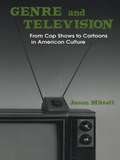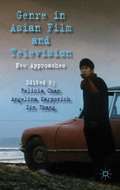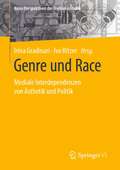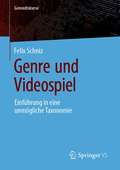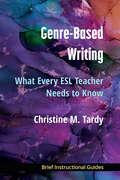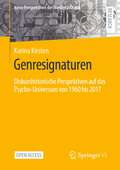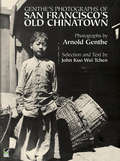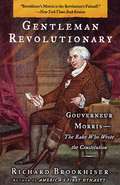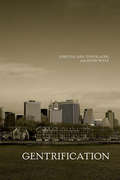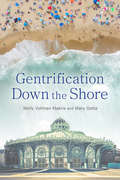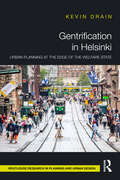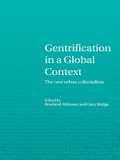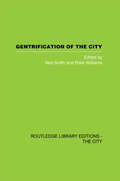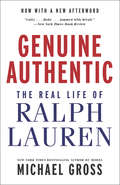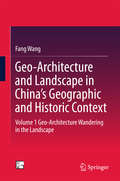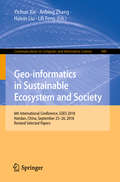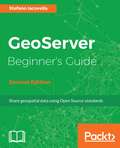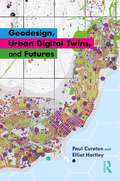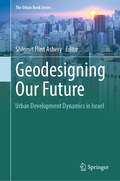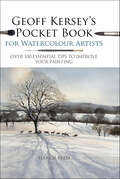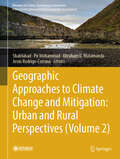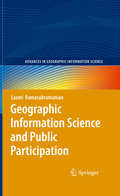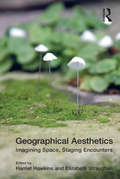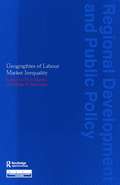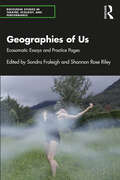- Table View
- List View
Genre and Television: From Cop Shows to Cartoons in American Culture
by Jason MittellGenre and Television proposes a new understanding of television genres as cultural categories, offering a set of in-depth historical and critical examinations to explore five key aspects of television genre: history, industry, audience, text, and genre mixing. Drawing on well-known television programs from Dragnet to The Simpsons, this book provides a new model of genre historiography and illustrates how genres are at work within nearly every facet of television-from policy decisions to production techniques to audience practices. Ultimately, the book argues that through analyzing how television genre operates as a cultural practice, we can better comprehend how television actively shapes our social world.
Genre in Asian Film and Television
by Felicia Chan Angelina KarpovichGenre in Asian Film and Television takes a dynamic approach to the study of Asian screen media previously under-represented in academic writing. It combines historical overviews of developments within national contexts with detailed case studies on the use of generic conventions and genre hybridity in contemporary films and television programmes.
Genre und Race: Mediale Interdependenzen von Ästhetik und Politik (Neue Perspektiven der Medienästhetik)
by Ivo Ritzer Irina GradinariDie Kategorie Race gewinnt aktuell wieder stärker an politischer Sichtbarkeit, bedingt vor allem durch die Black-Lives-Matter-Bewegung, Migration und Flucht, nicht zuletzt auch durch Theorieansätze wie Postcolonial Studies, Critical Race Theory, Intersektionalität oder Decolonizing der Gender Studies. Vor diesem Hintergrund gilt es zunächst medienspezifische Strategien in ihrer Vielfalt sowie historischen Entwicklung kritisch zu befragen, die zu rassistischem Denken und rassistischer Politik beigetragen haben und bis heute beitragen. Die Kategorie Genre als eine ambivalente und komplexe Wahrnehmungs- und Sinngebungsstruktur an der Schnittstelle von Produktion, Rezeption und Ästhetik bietet sich besonders an, um sich medientechnologischen Traditionen und Mitteln anzunähern, die Race politisch wirksam machen, verschiedene Ideologien bedienen, Affekte produzieren und zugleich jedoch immer auch Widerstände oder neue Sichtweisen und Artikulationsformen hervorbringen. Der Band versammelt unterschiedliche theoretische und analytische Ansätze, die anhand ausgewählter Gegenstände Einblicke in die Geschichte des Wechselbezugs von Genre und Race gewähren sowie sich mit dessen internationaler und nationalspezifischer Akzentuierung beschäftigen, wobei stets grundsätzliche Fragen nach dem Verhältnis von Visualität und Race sowie die epistemologische Kraft des Blickes im Fokus stehen.Mit Beiträgen von Lisa Andergassen, Thomas Bedorf, Julia Bee, Kyung-Ho Cha, Julia Dittmann, Irina Gradinari, Irmtraud Hnilica, Karina Kirsten, Michaela Ott, Johannes Pause, Nele Rein, Ivo Ritzer, Drehli Robnik, Peter Scheinpflug und Michaela Wünsch.
Genre und Videospiel: Einführung in eine unmögliche Taxonomie (Genrediskurse)
by Felix SchnizDiese Monographie erläutert Videospiele als mehrdimensionale und zutiefst wandelsame Konzepte als Wechselspiel dreier Dimensionen: Neben den in genretheoretischen Hybridansätzen zwischen Fiktionsgenre und Spielgenre sind es nämlich auch soziale Genrekomplexe, welche die Erfahrung des Spielers, insbesondere in Multiplayerspielen prägen. Das Videospiel zeigt sich als objet ambigué: ein Kunstobjekt, das sich endlich im Prozess der Interaktion mit dem Nutzer neu offenbart und positioniert.
Genre-Based Writing: What Every ESL Teacher Needs to Know
by Christine TardyIn Genre-Based Writing, author Christine Tardy defines genre and genre-based writing instruction and the five principles of a genre-based pedagogy. She then explains how to design genre-based writing activities. By discussing the genre-related practices and social and rhetorical aspects of genre, she is able to outline strategies for exploring rhetorical moves and playing with genre form in the classroom. In addition, the book provides general tips for bringing a genre approach into the writing classroom as well as several application activities and specific suggestions for classroom tasks.
Genresignaturen: Diskurshistorische Perspektiven auf das Psycho-Universum von 1960 bis 2017 (Neue Perspektiven der Medienästhetik)
by Karina KirstenKarina Kirsten diskutiert in diesem Open-Access-Buch die diskursive und historische Verfasstheit von Genres. Mit ‚Genresignaturen‘ entwickelt sie einen neuen analytischen Zugang, um die vielfältigen inter- und transmedialen Dynamiken und soziohistorischen Veränderungen von Genres beschreibbar zu machen. Am Beispiel des Psycho-Franchise veranschaulicht die Autorin, dass die wirkungsvolle und anhaltende Prägnanz von Genresignaturen aus komplexen Semantisierungs- und Differenzierungsprozessen resultiert, die zwischen Produktionskontexten, Distributionsnetzwerken und vielfältigen Diskursivierungen verlaufen. Indem sie in den materialnahen Analysen ‚Genre‘ zusammen mit Gendervorstellungen in den Fokus rückt, zeigt sie zudem, wie im Mantel der ikonischen Genregeschichte aktuelle Fragen und kulturelle Vorstellungen von Geschlechtlichkeit, Sexualität und Weißsein verhandelt werden. Zugleich werden Genresignaturen in Bezug auf Gender und Race sogar soweit umgeschrieben, dass wechselseitig queere Lesarten möglich werden. Genresignaturen bewahren so nicht nur Film- und Genregeschichte, sondern beziehen darüber hinaus zentrale gesellschaftliche Debatten ein.
Genthe's Photographs of San Francisco's Old Chinatown
by Arnold Genthe John Kuo Tchen130 rare photos offer fascinating visual record of Chinatown before the great 1906 earthquake. Informative text traces history of Chinese in California.
Gentleman Revolutionary: Gouverneur Morris, the Rake Who Wrote the Constitution
by Richard BrookhiserThe author of several books on the US founding fathers portrays the politics and pleasure-loving life of the rarely credited draftsman of the Constitution's final form and author of its "We the people" preamble, during the American and French Revolutions. Annotation ©2004 Book News, Inc., Portland, OR (booknews.com)
Gentrification
by Loretta Lees Tom Slater Elvin WylyThis first textbook on the topic of gentrification is written for upper-level undergraduates in geography, sociology, and planning. The gentrification of urban areas has accelerated across the globe to become a central engine of urban development, and it is a topic that has attracted a great deal of interest in both academia and the popular press. Gentrification presents major theoretical ideas and concepts with case studies, and summaries of the ideas in the book as well as offering ideas for future research.
Gentrification Down the Shore
by Mary Gatta Molly Vollman MakrisGentrification in cities in the United States is a hot topic, but this book contributes something new to the ongoing discussion by offering a rich case study of seasonal gentrification and its effects on long time residents. Asbury Park, New Jersey, an iconic beachfront city, was a dynamic resort community in the late 19th and early 20th century. As the century wore on Asbury Park became an illustration of some of the macro social and economic structural changes occurring in cities across the United States with its own beachfront twist. Yet in 2019 Asbury Park’s narrative has shifted again—named among the coolest small towns in America the city has multimillion-dollar beachfront condos attracting the attention of Hollywood stars and national media attention as a travel destination. Summer days in Asbury once again mean tourists strolling the boardwalk and dining by the Atlantic Ocean. But just across the railroad tracks from the seasonal crowds, many of Asbury’s long-time residents live below poverty and struggle for their share of this prosperity throughout all four seasons of the year. Molly Vollman Makris and Mary Gatta engage in a rich ethnographic investigation of Asbury Park to better understand the connection between jobs and seasonal gentrification and the experiences of long time residents in this beach-community city. They demonstrate how the racial inequality in the founding of Asbury Park is reverberating a century later. This book tells an important and nuanced tale of gentrification using an intersectional lens to examine the history of race relations, the too often overlooked history of the post-industrial city, the role of the LGBTQ population, barriers to employment and access to amenities, and the role of developers as the city rapidly changes. Makris and Gatta draw on in-depth interviews, focus groups, ethnographic observation as well as data analysis to tell the reader a story of life on the West Side of Asbury Park as the East Side prospers and to point to a potential path forward.
Gentrification in Helsinki: Urban Planning at the Edge of the Welfare State (Routledge Research in Planning and Urban Design)
by Kevin DrainThis book unravels the paradox of gentrification in Helsinki, Finland. Here, housing and welfare policies work well under certain conditions to prevent the worst outcomes of residential gentrification. Yet other forms of gentrification have proliferated in recent years, and local urban planning has gained a momentum in efforts to remake the urban landscape for business and tourism.Through a range of methods, each chapter approaches a different aspect of gentrification: the effectiveness of welfare policies against residential gentrification, the importance of retail gentrification and symbolic changes, the role of media and state-led tourism campaigns in promoting gentrification, the rise of vibrancy and sustainability as concepts driving regeneration, and the question of planning principles like participation in confronting gentrification. The reader will find a state system that supports a delicate balance in housing, but a local planning regime related to a more “generalized” gentrification. The results raise questions about the limits of the welfare state in an age of global competition.While new readers of gentrification will benefit from a deep engagement with the literature, the case of Helsinki is relevant to all students of planning, social sciences, and urban studies, as well as professionals in related fields.
Gentrification in a Global Context: The New Urban Colonialism (Housing and Society Series)
by Gary Bridge Rowland AtkinsonGentrification, a process of class neighbourhood upgrading, is being identified in a broader range of urban contexts throughout the world. This book throws new light and evidence to bear on a subject that deeply divides commentators on its worth and social costs given its ability to physically improve areas but also to displace indigenous inhabitants.Gentrification in a Global Perspective brings together the most recent theoretical and empirical research on gentrification at a global scale. Each author gives an overview of gentrification in their country so that each chapter retains a unique approach but tackles a common theme within a shared framework. The main feature of the book is a critical and well-written set of chapters on a process that is currently undergoing a resurgence of interest and one that shows no sign of abating.
Genuine Authentic: The Real Life of Ralph Lauren
by Michael GrossA fascinating and comprehensive look into the life of American fashion designer Ralph Lauren, now with an afterword.“Deep-dish...sharp-clawed...honestly admiring.”—New York TimesThere are at least two Ralph Laurens. To the public he's a gentle, modest, yet secure and purposeful man. Inside the walls of Polo Ralph Lauren, though, he was long seen by some as a narcissist, an insecure ditherer, and, at times, a rampaging tyrant. Michael Gross, author of the bestsellers Model and 740 Park, lays bare the truths of this fashion emperor's rise, and reveals not only the secrets of his meteoric success in marketing our shared fantasies, but also a widely unknown side that's behind the designer’s chic façade.
Geo-Architecture and Landscape in China's Geographic and Historic Context
by Fang WangThis book explores the concept of geo-architecture by analyzing the ways architectures are related to the local geography, including mingling or contrasting with surrounding landscape, adapting to mountainous or aquatic terrain, and selection of construction materials. Architectures build with such skillfully contrived strategies and techniques have become live exhibit of folk customs and served to record in profound detail the long history of mankind's recognition of nature. The combined effect is such that the architecture grows out of the surrounding natural and human environment. This book is the third of a 4-volume book series. The series develops the innovative concept of "geo-architecture" by exploring the myriad influences of natural, human and historical factors upon architecture. These influences are considered in three categories, namely, interaction between architecture and nature, interaction between architecture and its human users and change in architecture over time--each category serves as a lens. Augmenting these lenses is the Time-Person-Place concept applied different geographic. The analysis ultimately focuses on two aspects: geographic influence on architecture and architectural response to geography. The over 1000 pictures of case architectures enriches the study with stunning and unique visual angles. "This unprecedented work will be a unique and valuable contribution to the literature. Integrating as it does the disciplines of architecture, landscape architecture, and geography, Wang Fang's voice is original, compelling, and will be much appreciated by English-speaking readers (and inside China, too, I can only imagine. )" Stephen M Ervin Assistant Dean Graduate School of Design, Harvard University July 2nd, 2013 "One reason for why there would be interest is because her research would fill some significant gaps in the literature. What is novel about Dr. Wang's series is that she further extends this intellectual project of looking at Chinese architecture through Chinese eyes, by taking it one provocative step further. " Annette M. Kim Associate Professor Department of Urban Studies and Planning, M. I. T. July 1st, 2013
Geo-informatics in Sustainable Ecosystem and Society: 6th International Conference, GSES 2018, Handan, China, September 25–26, 2018, Revised Selected Papers (Communications in Computer and Information Science #980)
by Yichun Xie Anbing Zhang Haixin Liu Lili FengThis book constitutes the refereed proceedings of the 6th International Conference on Geo-informatics in Sustainable Ecosystem and Society, GSES 2018, held in Handan, China, in September 2018. The 46 papers presented in this volume were carefully reviewed and selected from 153 submissions and focus on spatial data acquisition, processing and management, modeling and analysis, and recent applications in the context of building healthier ecology and resource management using advanced remote sensing technology and spatial data modeling and analysis.
GeoServer Beginner's Guide - Second Edition
by Stefano IacovellaThis step-by-step guide will teach you how to use GeoServer to build custom and interactive maps using your data. About This Book • Exploit the power of GeoServer to provide agile, flexible, and low -cost community projects • Share real-time maps quickly • Boost your map server's performance using the power and flexibility of GeoServer Who This Book Is For If you are a web developer with knowledge of server side scripting, have experience in installing applications on the server, and want to go beyond Google Maps by offering dynamically built maps on your site with your latest geospatial data stored in MySQL, PostGIS, MySQL, or Oracle, this is the book for you. What You Will Learn • Install GeoServer quickly • Access dynamic real-time geospatial data that you can easily integrate into your own web-based application • Create custom styles for lines, points, and polygons for great-looking maps • Command GeoServer remotely using REST • Tune your GeoServer instance for performance • Move GeoServer into production • Learn advanced topics to extend GeoServer's capabilities In Detail GeoServer is an opensource server written in Java that allows users to share, process, and edit geospatial data. This book will guide you through the new features and improvements of GeoServer and will help you get started with it. GeoServer Beginner's Guide gives you the impetus to build custom maps using your data without the need for costly commercial software licenses and restrictions. Even if you do not have prior GIS knowledge, you will be able to make interactive maps after reading this book. You will install GeoServer, access your data from a database, and apply style points, lines, polygons, and labels to impress site visitors with real-time maps. Then you follow a step-by-step guide that installs GeoServer in minutes. You will explore the web-based administrative interface to connect to backend data stores such as PostGIS, and Oracle. Going ahead, you can display your data on web-based interactive maps, use style lines, points, polygons, and embed images to visualize this data for your web visitors. You will walk away from this book with a working application ready for production. After reading GeoServer Beginner's Guide, you will be able to build beautiful custom maps on your website using your geospatial data. Style and approach Step-by-step instructions are included and the needs of a beginner are totally satisfied by the book. The book consists of plenty of examples with accompanying screenshots and code for an easy learning curve.
Geodesign, Urban Digital Twins, and Futures
by Paul Cureton Elliot HartleyGeodesign, Urban Digital Twins, and Futures explores systems, processes, and novel technologies for planning, mapping, and designing our built environment. In a period of advancing urban infrastructure, technological autonomy in cities, and high-performance geographic systems, new capabilities, novel techniques, and streamlined procedures have emerged concurrently with climatic challenges, pandemics, and increasing global urbanisation. Chapters cover a range of topics such as urban digital twins, GeoBIM, geodesign and collaborative tools, immersive environments, gamification, and future methods. This book features over 100 international projects and workflows, five detailed case studies, and a companion website. In addition, this book examines geodesign as an agent for collaboration alongside futuring methods for imagining and understanding our future world.The companion website for this book can be accessed at http://geodesigndigitaltwins.com.
Geodesigning Our Future: Urban Development Dynamics in Israel (The Urban Book Series)
by Shlomit Flint AsheryThis book examines how map-based collaboration software can facilitate negotiations in areas undergoing contentious pressures for significant change. Based on case studies from Israel, it aims to introduce a useful model of planning implementation as an outcome of complex interaction to reduce the gap between planning and urban reality. It puts an analytical realist foundation for a productive discussion of the role of future planning and bares meaningful scientific contributions to the general frame of the negotiating process and implementation, which still needs further research and elaboration.Geodesign, a cutting-edge planning approach that is rooted in the history of planning practice, has become one of the most popular approaches for sustainable planning and design activities after 2000s. Planners tend to think of design at a site scale, but geodesign covers a variety of scales, bridging the gap between the regional and the local contexts.This is important because to be practically effective and politically prudent, "smart growth" plans need to make sense across a spectrum of scales and disciplines. This ranges from design, urban design, community planning, town and city planning, and regional planning, up to planning for mega-regions.
Geoff Kersey’s Pocket Book for Watercolour Artists: Over 100 Essential Tips to Improve Your Painting
by Geoff KerseyGeoff Kersey shares his expertise in this book packed full of tips for watercolour painters. Learn all you need to know, from what to buy, composing a painting and mastering techniques such as wet into wet and dry brush work, to how to paint skies, water, trees, buildings and more. The tips are clearly explained and illustrated through artwork and step-by-step photographs.This title was previously published as Geoff's Top Tips for Watercolour Artists. In this new, easy-to-use flexibinding format with an updated design, the books in the Watercolour Artists’ Pocket Books series bring you the best tips from some of Search Press's leading authors.
Geographic Approaches to Climate Change and Mitigation: Urban and Rural Perspectives (Advances in Science, Technology & Innovation)
by Abraham R. Matamanda Jesús Rodrigo-Comino Shahfahad Pir MohammadThis book provides an exploration of innovative geographic approaches to address the challenges posed by climate change, focusing on solutions across urban and rural contexts. Offering actionable insights, it bridges diverse disciplines to highlight practical strategies and evidence-based policies for a more sustainable and resilient future. The volume is organized into key themes that address global issues: sustainable governmental policies, urban planning, rural land use practices, transportation systems, food security, heritage conservation, and the socio-environmental impacts of climate change. From implementing nature-based solutions in African cities to reforestation practices in rural landscapes, and from reducing meat consumption to preserving cultural heritage at risk from rising sea levels, each chapter provides real-world case studies and forward-thinking strategies. The book addresses the importance of integrating diverse perspectives, emphasizing the need for cohesive policies and innovative solutions to mitigate climate impacts while fostering sustainable development. Topics like participatory democracy in climate action, the nexus between tourism and the environment, and leveraging shared electric vehicles for transit sustainability illustrate the multifaceted approach required to tackle global challenges. By examining methodologies such as fuzzy logic for territorial planning, innovative urban design for sustainable education environments, and advanced logistics for freight transportation, the book sets out to solve complex problems related to resource management, community resilience, and climate adaptation. It also sheds light on the socioeconomic and cultural dimensions of climate change, underscoring the importance of interdisciplinary collaboration and global action.
Geographic Information Science and Public Participation
by Laxmi RamasubramanianComputer-mediated participation is at the crossroads. In the early heady days of the digital revolution, access to "high" technologies such as GIS promised the empowerment of marginalized communities by providing data and information that was previously hidden away from public view. To a great extent, this goal has been achieved at least in the U.S. and Western Europe - data about a range of government initiatives and raw data about different aspects of spatial planning such as land use, community facilities, property ownership are available a mouse-click away. Now, that we, the public, have access to information, are we able to make better plans for the future of our cities and regions? Are we more inclusive in our planning efforts? Are we able to foster collaborative governance structures mediated by digital technologies? In the book, these issues will be discussed using a three-part structure. The first part of the book will be theoretical - it will review the literature in the field, establish a framework to organize the literature and to link three different subject areas (participation and community development, GIS and other related technologies, and planning processes). The second part of the book will be a series of success stories, case studies that review actual situations where participatory planning using GIS has enabled community wellbeing and empowerment. These case studies will vary in scale and focus on different planning issues (planning broadly defined). The final part of the book will step back to review alternative scenarios for the future, exploring where we are headed, as the technologies we are using to plan rapidly change.
Geographical Aesthetics: Imagining Space, Staging Encounters
by Elizabeth StraughanGeographical Aesthetics places the terms 'aesthetics' and 'geography' under critical question together, responding both to the increasing calls from within geography to develop a 'geographical aesthetics', and a resurgence of interdisciplinary interest in conceptual and empirical questions around geoaesthetics, environmental aesthetics, as well as the spatialities of the aesthetic. Despite taking up an identifiable role within the geographical imagination and sensibilities for centuries, and having what is arguably a key place in the making of the modern discipline, aesthetics remains a relatively under-theorized field within geography. Across 15 chapters Geographical Aesthetics brings together timely commentaries by international, interdisciplinary scholars to rework historical relations between geography and aesthetics, and reconsider how it is we might understand aesthetics. In renewing aesthetics as a site of investigation, but also an analytic object through which we can think about worldly encounters, Geographical Aesthetics presents a reworking of our geographical imaginary of the aesthetic.
Geographies of Labour Market Inequality (Regions and Cities)
by Ron Martin Philip S. MorrisonIn recent years, the local dimensions of the labour market have attracted increasing attention from academic analysts and public policy-makers alike. There is growing realization that there is no such thing as the national labour market, instead a mosaic of local and regional markets that differ in nature, performance and regulation. Geographies of Labour Market Inequality is concerned with these multiple geographies of employment, unemployment, work and incomes, and their implications for public policy.
Geographies of Us: Ecosomatic Essays and Practice Pages (Routledge Studies in Theatre, Ecology, and Performance)
by Sondra Fraleigh Shannon Rose RileyGeographies of Us: Ecosomatic Essays and Practice Pages is the first edited collection in the field of ecosomatics.With a combination of essays and practice pages that provide a variety of scholarly, creative, and experience-based approaches for readers, the book brings together both established and emergent scholars and artists from many diverse backgrounds and covers work rooted in a dozen countries. The essays engage an array of crucial methodologies and critical/theoretical perspectives, including practice-based research in the arts, especially in performance and dance studies, critical theory, ecocriticism, Indigenous knowledges, material feminist critique, quantum field theory, and new phenomenologies. Practice pages are shorter chapters that provide readers a chance to engage creatively with the ideas presented across the collection. This book offers a multidisciplinary perspective that brings together work in performance as research, phenomenology, and dance/movement; this is one of its significant contributions to the area of ecosomatics.The book will be of interest to anyone curious about matters of embodiment, ecology, and the environment, especially artists and students of dance, performance, and somatic movement education who want to learn about ecosomatics and environmental activists who want to learn more about integrating creativity, the arts, and movement into their work.
